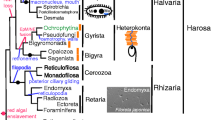Abstract
Three unselected cell lines of C. roseus maintained on a growth-associated alkaloid production medium were studied over a period of 2 to 5.5 years for the stability of alkaloid production (serpentine and ajmalicine). Large fluctuations in the total alkaloid content of 20-day-old cells were found for all three cell lines at each subculture over a two-year period. Growth rates increased during prolonged subculture and one cell line became unproductive after five years culture. By selection of small autofluorescent aggregates, high alkaloid production was restored in this cell line, while the parent line was found to be unresponsive to alkaloid induction treatments. The instability in both alkaloid production and spectrum and the loss of alkaloid productivity are discussed in relation to the selection pressures present during long-term maintenance of cell suspension cultures.
Similar content being viewed by others
Abbreviations
- 2,4-D:
-
2,4-dichlorophenoxyacetic acid
- nHS:
-
n-heptane sulphonate
References
Cresswell RC (1986) Selection studies on Catharanthus roseus. In: Morris P, Scragg AH, Stafford A, Fowler MW (Eds) Secondary Metabolism in Plant Cell Cultures (pp 230–236) Cambridge University Press.
Deus B (1978) In: Alfermann AW, Reinhard E (Eds) Production of Natural Compounds by Cell Culture Methods (pp 118–129) Gesellschaft für Strahlen und Umweltforschung mbH, München.
Deus-Neumann B, Zenk MH (1984) Instability of indole alkaloid production in Catharanthus roseus cell suspension cultures. Planta Medica 50: 427–431.
Dougall DK, Johnson JM, Whitten GM (1980) A clonal analysis of anthocyanin accumulation by cell cultures of wild carrot. Planta 149: 292–297.
Dougall DK (1979) Factors affecting the yields of secondary products in plant tissue cultures. In: Sharp WR, Larsen PO, Paddock EF, Raghavan O (Eds) Plant Cell and Tissue Culture (p 727) Ohio State University.
Ellis B (1982) Cell to cell variability in secondary metabolite production within cultured plant cell populations. In: Fujiwara A (Ed) Plant Tissue Culture 1982 (pp 395–396) Abe Photo Printing, Tokyo.
Mateles P (1978) In: Alfermann AW, Reinhard E (Eds) Production of Natural Compounds by Cell Culture Methods (p 187) Gesellschaft für Strahlen und Umweltforschung mbH, München.
Yamamoto Y, Mizuguchi R, Yamada Y (1982) Selection of a high and stable pigment producing strain in cultured Euphorbia milli cells. Theor Appl Genet 61: 113–116.
Morris P, Fowler MW (1980) Sucrose utilization by cell suspension cultures of Catharanthus roseus. Biochem Soc Trans 8: 638–639.
Morris P (1986) Regulation of product synthesis in cell cultures of Catharanthus roseus. II. Comparison of production media. Planta Medica 52: 121–126.
Morris P (1986) Regulation of product synthesis in cell cultures of Catharanthus roseus. III. Alkaloid metabolism in cultured leaf tissue and primary callus. Planta Medica 52: 127–131.
Morris P (1986) Long term stability of alkaloid productivity in cell suspension cultures of Catharanthus roseus. In: Morris P, Scragg AH, Stafford A, Fowler MW (Eds) Secondary Metabolism in Plant Cell Cultures (pp 257–262) Cambridge University Press.
Morris P (1986) Regulation of product synthesis in cell cultures of Catharanthus roseus. IV. Effect of culture temperature. Plant Cell Rep 5: 427–429.
Ogino T, Hiroaka N, Tabata M (1978) Selection of high nicotine producing cell lines of tobacco callus by single cell cloning. Phytochemistry 17: 1907–1910.
Sato F, Yamada Y (1984) High berberine producing cultures of Coptis japonica cells. Phytochemistry 23: 281–285.
Scragg AH (1988) Large scale cultivation of Helianthus vulgaris cell suspensions. J Biotechnol (submitted).
Stafford A, Smith L, Fowler MW (1985) Regulation of production synthesis in cell culture of Catharanthus roseus. I. Growth related indole alkaloid accumulation in batch culture. Plant Cell Tissue Org Cult 4: 83–94.
Zenk MH, El-Shagi H, Shulte U (1975) Anthroquinone production by cell suspension cultures of Morinda citrifolia. Planta Medica (suppl) 75: 79–101.
Zenk MH, El-Shagi H, Ulbrich B (1977) Production of rosmarinic acid by cell suspension cultures of Coleus blumei. Naturwissenschaften 64: 585–586.
Zenk MH, El-Shagi H, Arens H, Stoeckigt J, Weiler EW, Deus B (1977) Formation of the indole alkaloids serpentine and ajmalicine in cell suspension cultures of Catharanthus roseus. In: Barz W, Reinhard E, Zenk MH (Eds) Plant Tissue Culture and its Biotechnological Applications (pp 27–43) Springer-Verlag, Berlin.
Author information
Authors and Affiliations
Rights and permissions
About this article
Cite this article
Morris, P., Rudge, K., Cresswell, R. et al. Regulation of product synthesis in cell cultures of Catharanthus roseus. V. Long-term maintenance of cells on a production medium. Plant Cell Tiss Organ Cult 17, 79–90 (1989). https://doi.org/10.1007/BF00046853
Received:
Accepted:
Issue Date:
DOI: https://doi.org/10.1007/BF00046853




